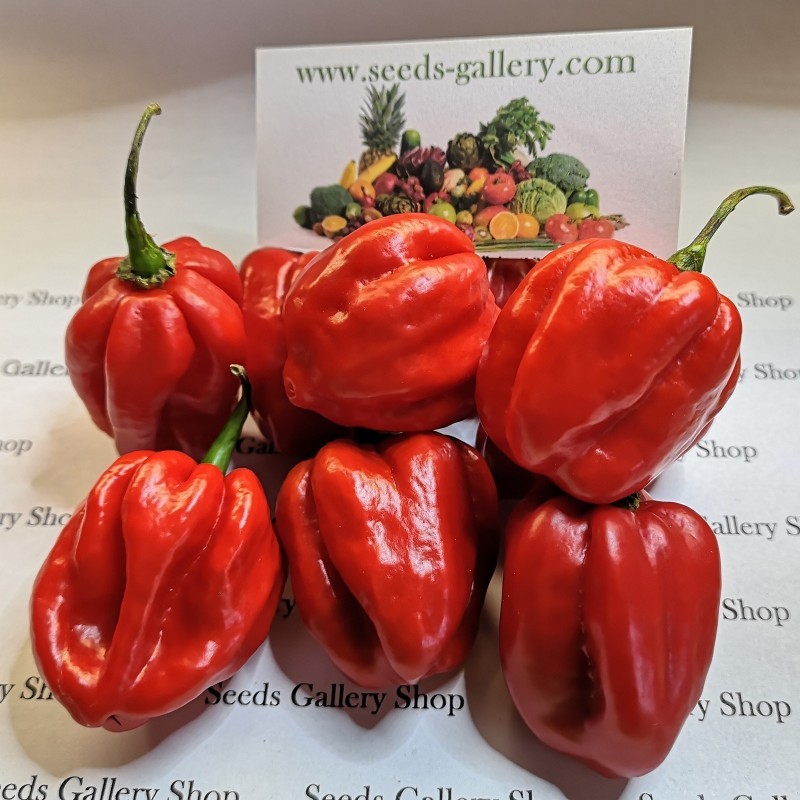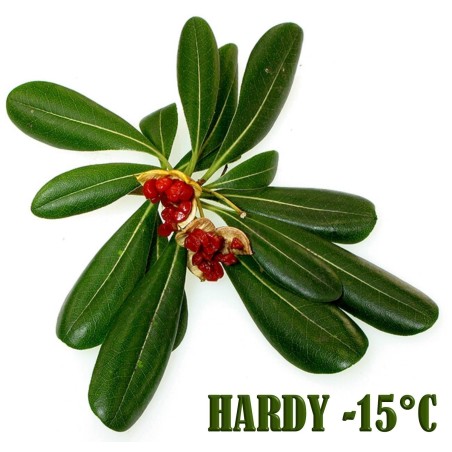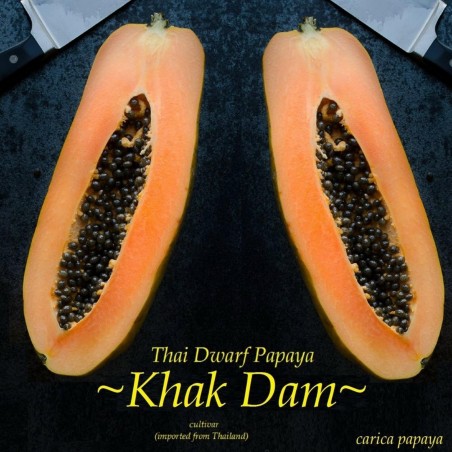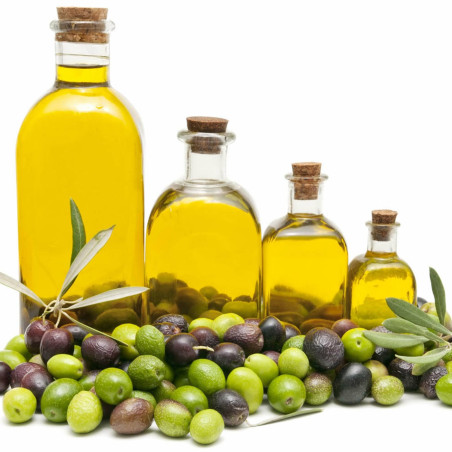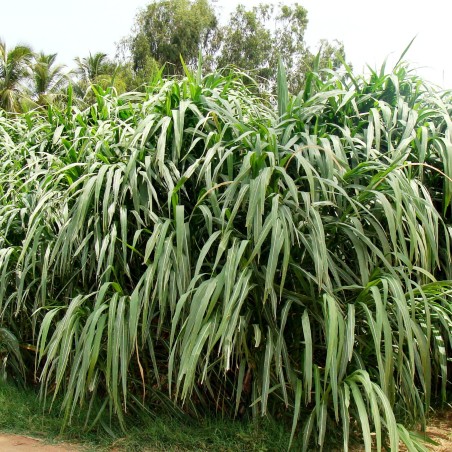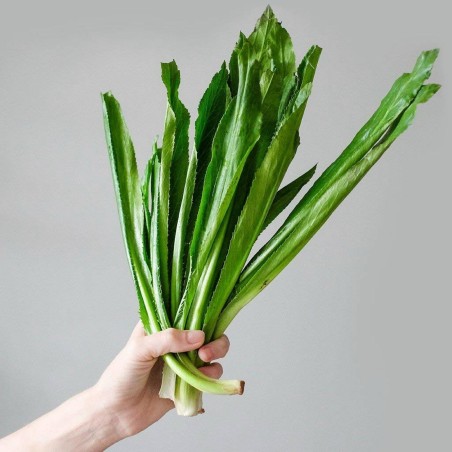
100 Seeds Habanero Red
100 Seeds Habanero Red (Capsicum chinense)
Price for Package of 100 seeds.
The habanero is a variety of chili pepper. Unripe habaneros are green, and they color as they mature. The most common color variants are orange and red, but the fruit may also be white, brown, yellow
100 Seeds Habanero Red (Capsicum chinense)
Price for Package of 100 seeds.
The name indicates something or someone from La Habana (Havana). In English, it is sometimes spelled and pronounced habañero, the tilde being added as a hyperforeignism patterned after jalapeño.
Origin and current use
The habanero chili comes from the Amazon, from which it was spread, reaching Mexico. A specimen of a domesticated habanero plant, dated at 8,500 years old, was found at an archaeological site in Peru.[citation needed] An intact fruit of a small domesticated habanero, found in pre-ceramic levels in Guitarrero Cave in the Peruvian highlands, was dated to 6500 BC.
The habanero chili was disseminated by Spanish colonists to other areas of the world, to the point that 18th-century taxonomists mistook China for its place of origin and called it Capsicum chinense ("the Chinese pepper").
Today, the largest producer is the Yucatán Peninsula, in Mexico. Habaneros are an integral part of Yucatecan food, accompanying most dishes, either in natural form or purée or salsa. Other modern producers include Belize, Panama, Costa Rica, Colombia, Ecuador, and parts of the United States, including Texas, Idaho, and California.
The Scotch bonnet is often compared to the habanero, since they are two varieties of the same species, but they have different pod types. Both the Scotch bonnet and the habanero have thin, waxy flesh. They have a similar heat level and flavor. Both varieties average around the same level of pungency, but the actual degree varies greatly from one fruit to another according to genetics, growing methods, climate, and plant stress.
In 1999, the habanero was listed by Guinness World Records as the world's hottest chili, but it has since been displaced by other peppers. The Bhut jolokia (or ghost pepper) and Trinidad moruga scorpion have since been identified as native Capsicum chinense subspecies even hotter than the habanero. Breeders constantly crossbreed subspecies to attempt to create cultivars that will break the record on the Scoville scale. One example is the Carolina Reaper, a cross between a Bhut jolokia pepper with a particularly pungent red habanero.
Cultivation
Habaneros thrive in hot weather. Like all peppers, the habanero does well in an area with good morning sun and in soil with a pH level around 5 to 6 (slightly acidic). Habaneros which are watered daily produce more vegetative growth but the same number of fruit, with lower concentrations of capsaicin, as compared to plants which are watered only when dry (every seven days). Overly moist soil and roots will produce bitter-tasting peppers. Daily watering during flowering and early setting of fruit helps prevent flower and immature fruit from dropping, but flower dropping rates are reported to often reach 90% even in ideal conditions.
The habanero is a perennial flowering plant, meaning that with proper care and growing conditions, it can produce flowers (and thus fruit) for many years. Habanero bushes are good candidates for a container garden. In temperate climates, though, it is treated as an annual, dying each winter and being replaced the next spring. In tropical and subtropical regions, the habanero, like other chiles, will produce year round. As long as conditions are favorable, the plant will set fruit continuously.
Cultivars
Several growers have attempted to selectively breed habanero plants to produce hotter, heavier, and larger peppers. Most habaneros rate between 200,000 and 300,000 on the Scoville scale. In 2004, researchers in Texas created a mild version of the habanero, but retained the traditional aroma and flavor. The milder version was obtained by crossing the Yucatán habanero pepper with a heatless habanero from Bolivia over several generations.
A 'Caribbean Red,' a cultivar within the habanero family, has a citrusy and slightly smoky flavor, with a Scoville rating ranging from 300,000 to 445,000 Scoville units.


Your review appreciation cannot be sent
Report comment
Report sent
Your report cannot be sent
Write your review
Review sent
Your review cannot be sent
🌍 Global Delivery from the EU
We ship worldwide from the European Union via registered mail with delivery confirmation.
📦 Shipment Tracking
To find your tracking number, log in to your account and go to Order History > Details.
Global tracking: 17Track
For tracking numbers like RGxxxxxxHR: Posta.hr tracking
🕒 Note: Tracking information becomes available up to 24 hours after your order is shipped.
⚠️ Important Notices
Cash on delivery is not available.
Regularly check your spam/junk email folder for notifications.
All inquiries must be submitted via our contact form on the website.
Messages sent via regular email may not be received.
📱 Required at Checkout
Always include your mobile phone number with international dialing code.
Example for Hungary: +36 20 123 4567
🚚 Delivery Policy
Registered shipments require a signature from the recipient.
We do NOT deliver:
to P.O. boxes
to neighbors
if you are not home to receive the package
📬 If a P.O. box address is provided and the package is lost or undeliverable, it will not be refunded.
↩️ Return & Reshipping
If your package is returned to us:
You will be charged €2 for return shipping
You are responsible for reshipping costs as well
⏱ Delays & Tracking Issues
If tracking shows the package is still with the sender, it means it is in transit.
Contact your local post office with the tracking number for updates.
We are not a postal service and cannot track your package for you.
We are not responsible for shipping delays.
🔍 We can only start an investigation into a lost shipment 30 days after the dispatch date.
✈️ Delivery Options
| Type of Delivery | Processing Time | Insured | Possible Delays | Notes |
|---|---|---|---|---|
| Standard | 7–10 business days | ❌ | 7–14 days | Basic shipping option |
| Priority | 1–7 business days | ❌ | 3–10 days | Faster processing, not faster shipping |
| Insured | 1–7 business days | ✅ | 3–10 days | Refund if the package is lost (up to €150) |
🕒 Estimated Delivery Time:
Within the EU: 3–20 days
Worldwide: 5–30 days
Example delivery times to the USA: 27, 22, 19, 17, 13 days
💳 Payment Options
💶 Bank Transfer (SEPA / IBAN / SWIFT-BIC)
Always include your order reference (e.g., SGS-19811702) in the payment description.
If we cannot match your payment to your order, it may cause delays or cancellation.
Orders are automatically canceled if payment is not received within 7 days.
🅿️ PayPal
We accept EUR currency only via PayPal.
Please change your currency to Euro during checkout.
💳 Card Payment
We accept: Visa, MasterCard, American Express, CB, Diners Club, Discover, China UnionPay, JCB, etc.
💡 Buyers are responsible for all transaction fees. Please send us your transaction details so we can process your order promptly.
📅 Other Information
Orders are not processed or shipped on Saturdays or Sundays.
Always check the Important Notices on our website before placing an order (e.g., holiday schedules, special conditions).
📫 For any questions, please use only the contact form on our website.
Emails sent outside of this form will not be received.
Related Products

